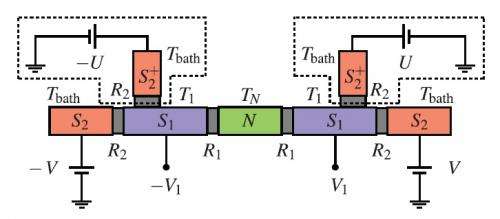June 19, 2014 feature
Superconducting refrigerator cools via tunneling cascade

(Phys.org) —Cooling microscopic objects to temperatures near absolute zero requires unconventional refrigeration technologies. One microscale cooling method is superconducting refrigeration, in which refrigerators extract hot quasiparticles (collective excitations) from non-superconducting metals and transport them to superconducting metals. Superconducting refrigerators can cool microscopic objects down to below 1 K.
In a new paper published in Applied Physics Letters, a team of researchers, M. Camarasa-Gómez, et al., from Italy and France, has proposed a new design for a superconducting refrigerator in which cooling is performed in a cascade of steps. Due to this multistage operation, the refrigerator can cool down a normal metal from 0.5 K to 100 mK with improved performance compared to similar refrigerators.
Superconducting refrigerators are typically composed of superconductors (S), normal metals (N), and tunnel barriers (I) that are often arranged in a symmetric configuration; for example, SINIS. When a voltage is applied to the superconductors, hot quasiparticles in the normal metal tunnel through the tunnel barriers to the superconductors, cooling the normal metal.
The proposed design consists of the SINIS configuration with an additional superconducting tunnel contact on each end: S2IS1INIS1IS2. A voltage is applied to the S2 superconductors, causing hot quasiparticles to first tunnel from the normal metal to the S1 superconductors, and then to the S2 superconductors. Each tunneling event removes heat, resulting in a heat current that flows from the inside to the outside of the refrigerator.
"A cascade geometry allows to cool a first superconducting stage, which is used as a local thermal bath in a second stage," the researchers explain in their paper.
This cascade cooling method requires that the components have certain properties, in particular resistances, in order to operate correctly. The researchers expect that these requirements can be easily implemented in a practical device using a combination of vanadium, aluminum, and copper.
The superconducting cascade electron refrigerator could be used for cooling both microscopic and macroscopic objects, including ultracold sensors for astronomical instruments.
More information: M. Camarasa-Gómez, et al. "Superconducting cascade electron refrigerator." Applied Physics Letters 104, 192601 (2014). DOI: 10.1063/1.4876478
Journal information: Applied Physics Letters
© 2014 Phys.org










.jpg)










